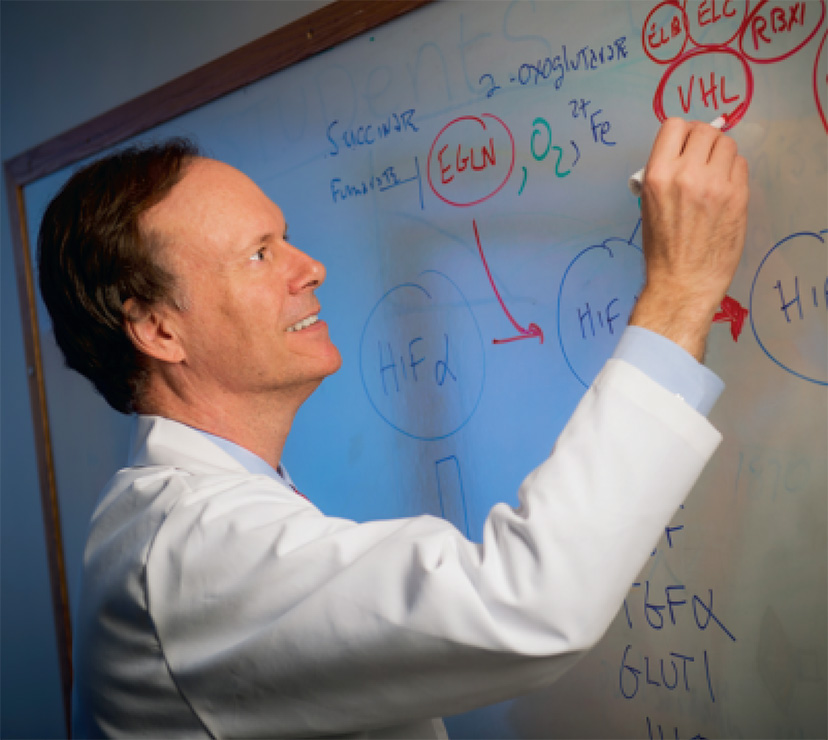By William G. Kaelin, Jr., MD, Damon Runyon Board Member and Vice Chair of Scientific Programs, the Sidney Farber Professor of Medicine at the Dana-Farber Cancer Institute, Harvard Medical School, and a Howard Hughes Medical Institute Investigator.
 As a cancer researcher, I am frequently asked when the disease will be cured. In truth, I ask myself the same question every day.
As a cancer researcher, I am frequently asked when the disease will be cured. In truth, I ask myself the same question every day.
In the 1980s, I was a physician, and I saw at first hand how cancer devastated my patients and their families. In the 1990s, I became a laboratory-based researcher, convinced that we needed a much deeper understanding of cancer if we were to develop better treatments.
In 2003, my wife, a celebrated breast cancer surgeon, underwent surgery, chemotherapy and hormonal therapy for an early stage breast cancer that she had self-diagnosed between two operating room cases. Although she survived, her chemotherapy caused neurological toxicity that prevented her from returning to the profession she loved. In 2010, she developed a malignant brain tumour, unrelated to her breast cancer. Despite surgery, state-of-the-art radiotherapy and other medical interventions, it killed her five years later. I share the frustration that progress against cancer has not come faster, especially given the resources that have been marshalled against it for decades.
In thinking about cancer, it is helpful to understand some of the differences between science and engineering. Scientists produce new knowledge, and engineers apply that knowledge. In 1960, President Kennedy challenged us to put a man on the moon within a decade. In 1971, President Nixon declared a war on cancer. While the former led to the successful lunar landing in 1969, the war on cancer continues.
But putting a man on the moon was an engineering problem, thanks to scientists such as Galileo and Newton. That is why it lent itself to a timeline, with stipulated deliverables. I understand the urge to regard cancer as an analogous case, solvable by simply reorganising the research community and resourcing it appropriately. But it isn’t. Cancer remains primarily a scientific problem.
For example, we now know that cancer is caused primarily by the accumulation of DNA alterations (mutations) in particular cells in the body. The first draft of the normal sequence of human DNA – needed to systematically identify these mutations – did not appear until 2000. Only then did this particular battle in the war on cancer become an engineering problem: how to make routine DNA sequencing affordable. That has now been achieved, and it has revolutionised diagnosis. But it is only the first step on a long road towards treatment.
Scientists still have to learn how, mechanistically, each mutation contributes to the misbehaviour of cancer cells and the tractable vulnerabilities that it imparts upon them. Making matters worse, cancer-causing mutations have been identified in hundreds of different genes. Furthermore, unlike single-gene disorders such as sickle cell disease or cystic fibrosis, cancers are typically caused by the accumulation of multiple mutations acting in concert, much like the tumblers of a lock falling into place, and no two cancers have the same combination of mutations. Even the cells within the same tumour can create genetically distinct progeny that serve as a reservoir for treatment-resistant variants. While an increasing number of cancers are now treatable, too many remain intractable.
More knowledge about basic cancer biology is imperative before engineering can truly take over. Such discovery science – especially the type that fundamentally changes the way we think about a problem – is often driven by creative individuals who have been allowed to follow their curiosity. Scientists should be held accountable for the resources they are given, but forcing them into teams and holding them to a predetermined schedule for breakthroughs risks creating a herd mentality inimical to heretical, transformative thinking. The next big advance in, say, breast cancer might come from someone studying breast cancer, but it could also come from a basic scientist studying fundamental biological mechanisms in a model organism such as the fruit fly or the worm. And it may come tomorrow, or it may come 20 years from now.
This is why the pharmaceutical industry relies on the public sector, including governments and philanthropic organisations, to fund early stage discovery science, which is typically conducted in academic laboratories; most companies cannot justify investments in open-ended, curiosity-driven discovery science to their investors. Linking academic research funding to perceived clinical utility not only threatens this symbiotic relationship but also has other unintended consequences. For example, some of the problems with the irreproducibility of published scientific papers almost certainly stem from basic science investigators being coerced, by funders and publishers, into conducting applied science experiments that they are poorly trained to perform.
Knowledge, like art, is one of the greatest gifts we can give to future generations, and it is clear that the more we invest in discovery science, the faster we will generate it. But the fruits of that knowledge cannot be predicted in advance. For the benefit of all the stakeholders involved in cancer research – most importantly, patients and their families – we must acknowledge this, instead of overpromising that investments in science will transform care in the short term.
Originally published in the Times Higher Education







